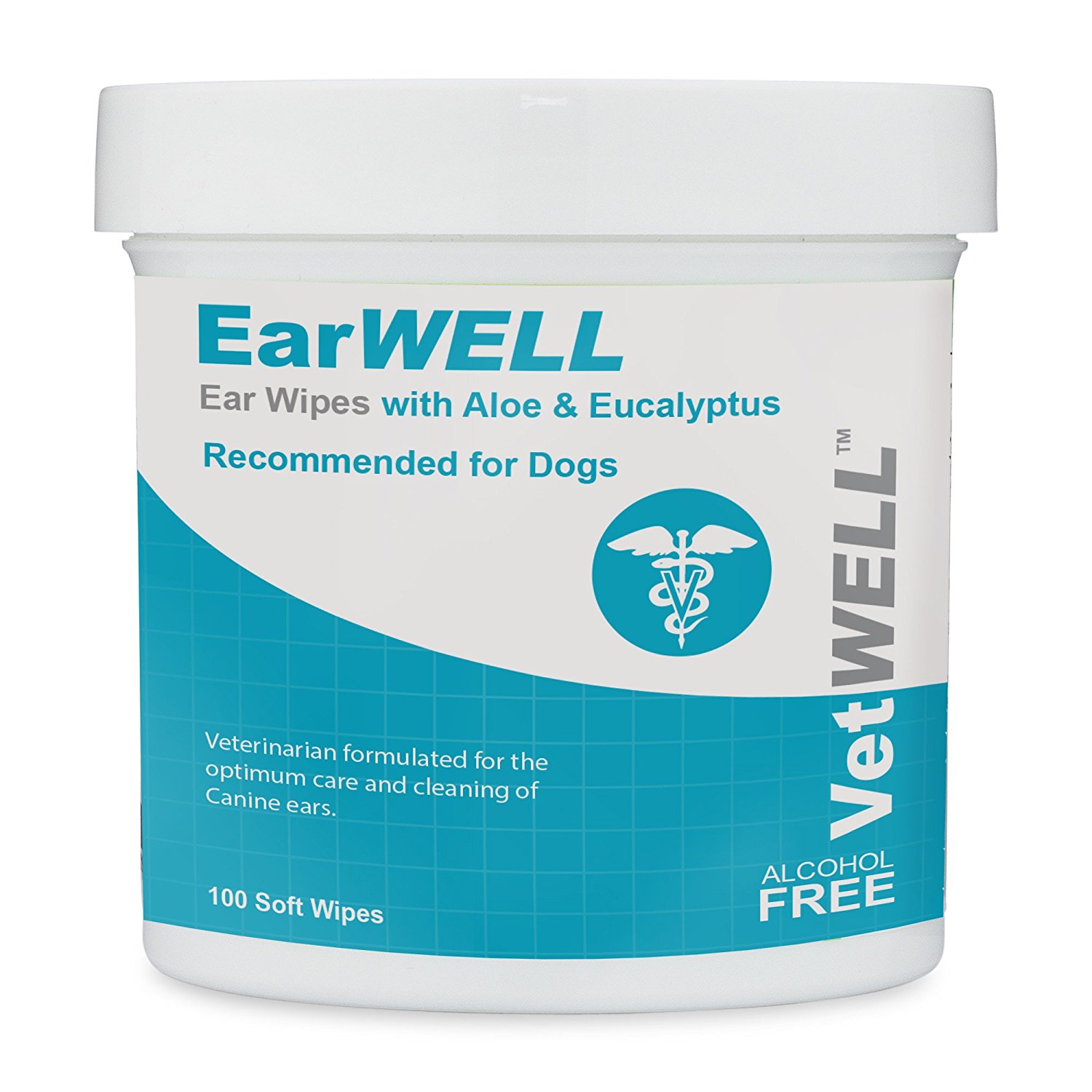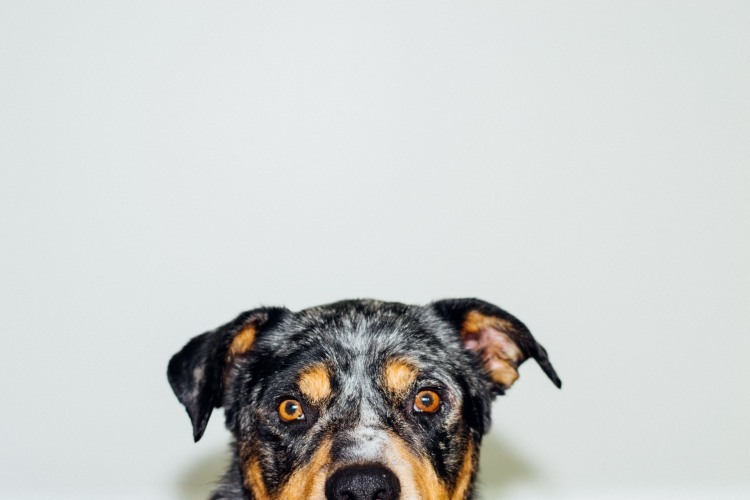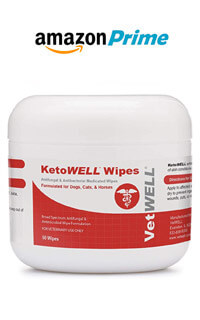About Us
Blog Archive
-
▼
2019
(1687)
-
▼
April
(101)
- Nebraska Cellist’s Gets Surprising Reaction From S...
- Service Dog and His Human Blow Audiences Away in N...
- The Doggy School Bus Takes Dogs On Play Dates Than...
- 11 Must-See Ideas to Celebrate Dog Mamas This Moth...
- Puppy Training: Better Taught Alone, Online or At ...
- Cleveland Brown’s Superstar Holds Amazing Day For ...
- You Won’t Believe Where These Dogs Are Going On Th...
- If Your Dog Sheds a Puppy Daily, They Probably Nee...
- Does Your Dog Love Stuffed Toys Or Love Unstuffing...
- ‘Unadoptable’ Pup Finds Surprising Job in Law Enfo...
- US Army Servicewoman Rescues ‘Pirate’ After 7 Year...
- Heartbreaking Reason Why Shelter Pup Refused Let G...
- Study Reveals Surprising Find Regarding Women Who ...
- Is Your Dog’s Breed On This List? Make Sure You’re...
- Should Dogs Be Shocked, Choked, or Pronged?
- Smiling Dog: Honey
- Animal Abuse Type and People's Relationship to the...
- 20 Dog Breeds That Kiss The Most
- Senior Dog with a “Different” Face Mends Woman’s B...
- Tiny Pup Survives Being Drugged, Beaten, and Burned
- 6 Unbeatable Ways To Eliminate Dog Hair From Your ...
- Is Your Dog Suffering From Hot Spots? This Low Cos...
- This Dentist Gave Up A Successful Career To Save T...
- How Dogs' Names Have Changed Through History
- Rescue Rebuild Fixes Fire-Damaged Shelter and Make...
- Teeny Tiny Bottle Babies Are Now Thriving Thanks t...
- Police Officer with PTSD Forms an Instant Bond wit...
- Lucky Pup Survives Getting Carried Away By A Flyin...
- ‘Unadoptable’ Pup is Now Washington’s First Deaf K...
- Amazing Dog Swimming 135 Miles from Land Rescued b...
- K9 Hero Pierced by Over 200 Porcupine Quills While...
- 3 Dangerous Ingredients You're Feeding Your Dog
- iHeartDogs Co-Founder Ate Dog Food and This Happened…
- Horrific Act of Cruelty Captured as Woman Dumps Pu...
- Does Your Pooch Like To Smooch? The Answer May Sur...
- This Enthusiastic Dog Ran Over His Owner After Suc...
- How To Determine A Dog’s Age
- Dog Slowing Down? Slower to Rise? Sleeping More? —...
- Older Dog Getting Stiff? This Golden Spice Can Get...
- Paranormal Pups: Can Your Dog See Ghosts?
- Retiring Baseball Player Thanks His Dog for His Su...
- Have an Itchy Dog with Allergies? Here’s Why They ...
- A Tiny Red Sea Creature Might Help Your Dog Beat S...
- Do Dogs Hold Grudges?
- When Dog Behavior Surprises Me
- Top Reasons to Get Your Dog’s DNA Tested
- A Dog A Day by Sally Muir
- 12 Signs You’ve Got a Mama’s Dog by Your Side
- Dog Nicknamed Cactus Joins Desert Race
- Normal Dog Vomit or Danger Sign? Gastritis Symptom...
- Are You Compatible with Your Dog’s Zodiac Sign?
- Mismatched Dog Pair Share A Bond More Powerful Tha...
- Is Your Dog Overweight? Here’s What You Need to Know
- Tiny Pup Narrowly Escapes Death Thanks to Four-Leg...
- 4 Breeds at Risk of Colitis – Learn How to Keep Yo...
- Dogs Scenting Cancer In Serum Samples
- Tilda Swinton Directs Dogs In Film
- Smiling Dog: Riley
- 11 Natural Remedies to Relieve Your Dog’s Anxiety
- Stray with a Broken Back Gets Her Wheels!
- Playful Pup Helps Heal Wounded Veteran
- Dog Nobody Wanted In Louisiana Finds Perfect Home ...
- Mailman’s Best Friend Leaves Lasting Legacy After ...
- Cushing’s Disease: What You Need To Know To Protec...
- Your Dog’s Eating Changes Could Be Telling You Som...
- Putting This In Your Dog’s Food Could Substantiall...
- Things Have Turned Around for Sweet, Sad Dog Cover...
- Dog Data Gathered by the U.S. Census
- Credit Union’s Pet Food Drive
- I Fed My Dogs Fresh Food for 30-Days – Here’s What...
- Scarred Dog Puts Abuse Behind Her and Joins Geary ...
- 7 Simple Ways to Keep Your Dog Healthy
- Museum Dedicated to Dogs Entertains with Classic A...
- These Bold Photos Take The E-Collar From “Shame” T...
- Dog Food Recall: Here We Go Again
- Does Your Dog Prefer Baby Talk? Signs Point to Yes
- Proposed NC Bill Would Ban Animal Abusers From Ado...
- New Orleans UPS Driver Poses For Adorable Photos W...
- Dogs Chase Bears Away
- 5 Ingredients That Are Toxic to Dogs in Household ...
- Candles & Air Fresheners: The Smell of Danger for ...
- This Blond Bombshell Can’t Understand Why She’s Sp...
- Does Your Dog Beg for Scraps? 5 Ways to Stop Begging
- Smiling Dog: Bodhi
- U.S. Soldiers Campaign To Bring Beloved Dog Home F...
- The 5 Surprising Ways Olive Oil Benefits Your Dog
- Shelter Animals Named Ohio’s Official State Pet
- Canine Klepto Steals Hearts…And Personal Belongings
- Improve Your Dog’s Health By Looking At His Poop
- Simple Ways to Improve Your Dog’s Dental Health
- Is your dog trying to tell you something?
- Fact or Fiction? Lifesaving Information About Hear...
- 5 Strange Eating Habits And What They Mean About Y...
- Science Says Having A Dog Could Have These Life-Sa...
- German Shepherd Puppy Training
- The Dachshund Museum’s First Anniversary
- The NomNomNow Microbiome Testing Kit Promotes A He...
- 10 Foods You Should Never Feed Your Dog
- Cuteness Alert! Limited Edition Easter Baskets Ful...
- The 2019 Pet Care Innovation Prize Winner Could Sa...
-
▼
April
(101)
Translate
Breaking News
April 2019
Puppy Training: Better Taught Alone, Online or At Class?

Puppy training! I LOVE puppy training. Puppies are such young, pliable loving balls of joy.
To be honest, I just moved and I have a little bit of “puppy-itis” and yes, I am certain that Webster’s dictionary should add this to their dictionary. It means that every time you see a puppy or smell puppy breath you have a desire to have your own furry bundle.
It seems everyone at my veterinary clinic has gotten a puppy lately, and those who haven’t acquired or rescued a puppy seems to be thinking about getting one.
And, I haven’t had a young puppy in almost 8.5 years. I watch old videos of her when she was just a year and a half and it melts my heart to see her learning and building the foundation to her obedience. My male dog was given to me at 6 months or 9 months (I’m getting too old to remember ha ha) and he just turned 7!
Anyway, I have a huge case of “puppy-itis”. I almost fostered a Doberman Pinscher puppy (7 months) last week.
But I believe that I have very different ideas about puppy training.
After all, 25 years of experience and literally hundreds of dogs and puppies in my house over that quarter decade have taught me a lot of things. First off, please don’t think I am a hoarder I have worked with several assistance dog programs and fostered many dogs in my time. Thankfully it has taught me a lot about puppy training, dog training and just general success with dog obedience.
And, I think my interpretation of what I like is very different.
Let me explain!
Online Classes

Let’s just admit it, not everyone is a dog trainer or a good dog trainer. For more on that click here http://bit.ly/2IPVCT4
Not everyone knows how to teach their dogs or pups impulse control and respect and these are just the basics of being a canine good citizen. These things should begin the moment your puppy crosses the threshold to his new home.
But dogs aren’t people, they aren’t really even close to being like people when it comes to their thinking.

If a dog thinks he can snatch your freshly made sandwich before you can get to it; he has won. He doesn’t understand that there is anything wrong with this behavior. In the wild, this is what would keep this dog alive and well sustained.
I might also mention that puppies don’t come home understanding that going “potty” in the house is wrong, much less BAD. He pees and poops when he needs to; this is how he was raised his first 6-8 weeks. Babies don’t pop out of the womb using the toilet or never making mistakes either.
But somehow the barrier between species gets lost and it is up to us humans and dog owners to learn how to communicate effectively when our new puppy comes home.
There is a fine line between losing your temper when your puppy has an accident or steals an item once and allowing him to continue these behaviors for months. I personally like as little correction as possible.
So, rewarding good behavior is crucial in teaching puppies.
I Recommend Online Puppy Classes and Impulse Control Classes First
I teach puppy kindergarten classes, so don’t misunderstand me. I love my puppy classes!!! But my puppy classes won’t delve into your potty training issues, nipping or impulse control too far. Of course we discuss it and I ask for problems people are experiencing each week. But, I don’t live with you or spend an hour with you; I have to split my time with all my clients issues.
For the most part puppy classes are for socialization (more on this in a bit).
First off, I don’t want you to wait for 4 to 6 weeks to get into a class before you begin training your puppy in puppy kindergarten classes.

I want you to learn to reward good behaviors.
I want you to reward your puppy when he sits.
I want you to reward your puppy when he lies down.
I want you to reward your puppy when he is just chilling with his toys in his toy box (yes, get him a toy box). Chewing is his toys is what you want him to chew right?
We spend SOOOOO much time telling our puppies what they do that is wrong. Get down, stop chasing the cat, drop it, leave it!!!! NO, NO BAD DOG!!!
But how often do we reward the puppy for things that are good or a better way to say this; for things we “expect”. We may expect him to lay down and chew his toys, but how does he know you like that if you are not praising and rewarding?
Please remember this is a different species with different rules. Although he wants to please you, he doesn’t really know how unless you tell him! Imagine going to a different country and they slap you or add pain when you do something wrong. You may quickly learn what brings the pain… but will you learn what these people want if they never praise or reward you? In essence you would live in a world of the unknown and fear of correction.
Personally I like keeping my puppies on leash when they are in the house, it helps with housebreaking and it forces you to train your puppy. If you ever sign up to raise a guide dog puppy they will force you to do this and within a few hours, days, weeks you will see why. A dog on a leash won’t be allowed to show the naughty behaviors that a dog with total freedom has and this helps to condition him and form good behaviors instead of constant wars of compliance.
I will tell you, having your puppy on a leash is a pain in the a*% but it is certainly crucial in their development. It also keeps them from eating and swallowing what is inappropriate. At my veterinary clinic alone we have seen or referred about 8 obstruction surgeries from dogs that are chewing or eating things that they shouldn’t. I guarantee if your dog is on leash and he grabs your $30 underwear you aren’t going to let him chew up and eat them!!!!

Leashes are also great for house training. When my puppy is on leash with me and we are watching a movie, him with his toys, me with my wine… I notice when he begins to do the “potty dance” and it keeps him from wandering off and having accidents. He is still going to make mistakes but they are certainly going to be less! Once he has the idea I can teach him to ring a bell and tell me he has to go outside.
Online dog training allows you the ability to understand more about where your dog is coming from and focus on the mundane until you are ready to move on to more advanced obedience.
I use “mundane” a little tongue in cheek because this kind of training is the most important.
Dogs who nip, dogs who have potty training problems, and dogs with impulse control issues end up on death row at the shelter. It is never the dog that doesn’t “sit” fast enough or have a pretty “flip finish”.
That doesn’t mean you should take this phase too long, set up homework for yourself and train at least 5 times per day but work at home where there are no distractions. This is the best environment for your dog to learn.

People have often thought they needed to take their dog “out” for training; this is just another myth. We learn best when distractions are lessened and where we are comfortable. We don’t take our children to the zoo and expect them to learn!! We put them in a quiet classroom where distractions are little to none and it is easiest to learn.
Puppy kindergarten class is like asking your child to learn at the zoo or Chuck E Cheese… this kind of environment is not conducive to learning. YOU might learn some basic things but it is likely to leave you frustrated because it is not advantageous to the dogs’ learning.
Train Alone
The next phase of training, once I have gotten my feet wet, is training alone.
I have already learned from my online classes.
I have taught impulse control and the basics, and I have a dog I am pretty darn happy with at home! After all, we spend most of our time at home anyway!
Now it is time to add distractions!

At first I actually recommend training on concrete or in a parking lot. Parking lots hold less smells that can add to your dog’s distraction and your frustration.
A raccoon that just ran through your back yard is much more odoriferous than the same coon that scooted across your church parking lot.
This allows me to keep my rewards and jackpots plentiful as we train, and it also helps to set him up for success. I, for instance, would never choose to take my herding dog to a field of sheep and expect him to keep up with his basic and advanced obedience.
I want to add distractions slowly. YES, he will make mistakes but if you set him up for success both of you will be less frustrated. I also take time of day into account. I am not going to train at 530 pm on Wednesday when everyone is off work and at the church. I am going to choose 1 pm on a Tuesday as a better time for success.
Work HARD! This doesn’t just come down to a month or two or work; this takes time. Eventually you should be able to walk through Walmart parking lot (on leash of course) and have his focus on you as well as impeccable obedience. Honestly I used to train inside and outside the dog park, so aim for big things!
Classes
Dog obedience training classes definitely have their place in your training regiment! For help finding a good one click here.

Can I admit, even I take obedience class? I never tell the trainer that I too am a trainer, although I suspect it is fairly noticeable, but I do it strictly for the socialization and proofing my obedience.
My dog is not obedient if he/she cannot listen around other dogs.
The best way to have a semi-controlled environment of dogs is in an dog obedience class.
I would mention, not all obedience trainers are created equal, go to a class where you agree with what is going on with the dogs in the class. Also get comfortable refusing to do things that you think aren’t going to be good for your dog.
One of my dogs is not over fond of dogs. So after our initial dog obedience and advanced dog obedience I enrolled him in a class. If you aren’t familiar with me and my training I am an advocate of eye contact and focus; so when stressed he looks at me. He doesn’t snarl or lunge or show negative behaviors but sometimes the trainer would ask me to work or socialize too close and I would refuse. I know my dog, I know what I trust with my dog and I ultimately am in control of him and his behavior.
It is much better to refuse to do a behavior and look like a conceited difficult individual than it is to have an incident where someone needs sutures and my dog is deemed dangerous. Ironically now we can literally touch other dogs when getting ready to dock dive, but it wasn’t worth the risk at the time. Trust your instincts, only you know your dog!
Actually you will learn a lot about how to handle and how not to handle other dogs. Your dog will be totally well trained and proofed while other dogs are whining and barking and pulling and this teaches you and confirms that classes are not the place to learn. Your dog is excelling because you gave him the skills he needed prior to the class.
Puppy Socialization
I do like good puppy socialization classes. Most of the time you can’t achieve the kind of obedience I describe in a dog under 6 months old.
So a little class and puppy play time can be a good thing… and a bad thing.
Be cautious again with your trainer. Some dog trainers will let all the dogs chase one dog or play too hard. Make sure your trainer knows what they are doing. It is better to avoid socialization class at all than it is to allow puppies to traumatize one another.
The only myth was that puppies under 6 months wouldn’t hurt each other, and while that is partly true they can traumatize each other mentally and that can last a lifetime.
Again, if you aren’t comfortable grab your puppy and exit, better safe than sorry.
This is a soul that you are going to have as part of your life for the next 10-15 years, so make sure you set him up early for a lifetime of success and being a good canine citizen everywhere he goes.
The post Puppy Training: Better Taught Alone, Online or At Class? appeared first on TheDogTrainingSecret.com.
via Whisker Therapy
Does Your Dog Love Stuffed Toys Or Love Unstuffing Them?
“He pulls the stuffing out in less than a minute!”
It’s a common lament among dog guardians that fleece toys don’t last. That’s because so many dogs unleash their inner beast on these unsuspecting soft balls of fluff. Sure, they have a good time destroying them, but the fun is over too quickly considering the price tag on these items. People whose dogs are fleece toy killers surely envy the dogs who are not just gentle but actually loving towards stuffed animals.
Stella, shown here with a pink stuffed poodle, is one such dog. She treats this toy much like a child treats a teddy bear. She loves this stuffed animal and seems to draw comfort from it. My family was taking care for Stella for a few days due to a death in her family that necessitated traveling out of state. At first she was a little nervous in our house, but her guardian had wisely sent the stuffed poodle along with her, which helped.
via Whisker Therapy
Is Your Dog’s Breed On This List? Make Sure You’re Cleaning Their Ears Once a Week
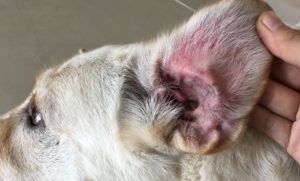
According to Nationwide Pet Insurance, ear infections were the top reason people visited a veterinarian in 2016. This painful condition could be alleviated if dog owners were more consistent about caring for their dog’s ears, such as frequent inspections, and weekly cleanings.
Which Dog Breeds Get The Most Ear Infections?
If your dog has floppy ears, in other words, the ear itself folds down over the ear canal, they are at a higher risk than other dogs for infections. The following breeds (and their mixes) are particularly prone to ear troubles:
- Doberman
- Labrador
- Golden Retriever
- Portugeuse Water Dog
- Poodle
- Schnauzer
- Cavalier King Charles Spaniel
- Basset Hound
- Bloodhound
- Afghan Hound
- Coonhound
- Springer Spaniel
- Cocker Spaniel
- Dachshund
- Shih Tzu
- Bullmastiff
- Beagle
- Newfoundland
- Saint Bernard
- Great Dane
- Weimaraners
- Mixes with any of the breeds above
How Regularly Should I Be Cleaning My Dog’s Ears?
But how often is best when it comes to cleaning your dog’s ears at home? Under-cleaning can allow infection causing yeast and bacteria to build up, while over-cleaning can strip away healthy wax and lead to irritation.
A healthy amount of wax in your dog’s ears actually helps lubricate and protect the delicate skin of the canals from infection. You want that healthy layer to remain, so cleanings should really only be performed when the ears are “dirty.”
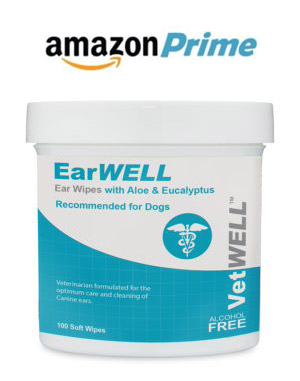 The length of time it takes for a dog’s ears to get dirty depends on breed, coat, activity level, wax production, and even humidity. In other words, it varies for every dog. The veterinarians at Banfield recommend once monthly cleanings as a basic rule of thumb for dogs with “normal” ears, however those who swim, roll in the dirt, or have a predisposition to infections (like the breeds listed above) may need weekly or daily cleanings.
The length of time it takes for a dog’s ears to get dirty depends on breed, coat, activity level, wax production, and even humidity. In other words, it varies for every dog. The veterinarians at Banfield recommend once monthly cleanings as a basic rule of thumb for dogs with “normal” ears, however those who swim, roll in the dirt, or have a predisposition to infections (like the breeds listed above) may need weekly or daily cleanings.
Check the ears each time you bathe your pup or after a vigorous play session like a trip to the dog park. A simple wipe of the outer ear and pinna (ear flap) is usually enough for healthy ears that have gotten a bit dirty. Apply a small amount of an appropriate, vet-approved cleanser to a cotton ball and simply swab the easy-to-reach outer folds of the ear. (we sell a veterinarian formulated ear cleanser that also gives back to shelter animals)
To determine if it is time for a good ear flushing, lift the pinna and look inside. Do you notice dirt, debris or excess brown buildup in the outer ear? If so, it may be time to break out the cleanser and do a more thorough job by cleaning out the L-shaped horizontal ear canal.
RELATED: Does Your Dog Have Constant Ear Infections? This Powerhouse Nutrient Can Help
When You Should NOT Clean Your Dog’s Ears
However, before you start scrubbing away, make sure that your pooch is not suffering from an ear infection. If you notice any of the following symptoms along with debris or discharge, do not attempt to clean the ears; consult your vet right away:
- Odor from the ears
- Puritic discharge (pus) or blood
- Excess scratching, pawing or rubbing at the ears
- Violent head shaking or “ear snapping”
- Redness and/or swelling of the pinna or ear canal
- Sensitivity or pain when ears are touched
It is important to make sure that your dog always has positive experiences when it comes to home care so that he or she will trust you with these treatments in the future. When in doubt, it’s best to check in with your vet.
Check out our favorite ear wipe brand on Amazon prime.
These statements have not been evaluated by the Food and Drug Administration. This product is not intended to diagnose, treat, cure, or prevent any disease. The information on this website is not intended to replace a one-on-one relationship with a qualified health care professional.
The post Is Your Dog’s Breed On This List? Make Sure You’re Cleaning Their Ears Once a Week appeared first on iHeartDogs.com.
via Whisker Therapy
Should Dogs Be Shocked, Choked, or Pronged?
"Collars are a vital part of dog ownership. They allow pet parents to walk their pup on a leash and they provide a place to hang ID and vaccination tags. However, if used in the wrong way, collars can lead to serious or even fatal injury." —Lindsay Lowe, "5 Ways Collars Can Harm Your Dog"
via Whisker Therapy
Smiling Dog: Honey
Cuddle aficionada, treat enthusiast, charming canine.
At an estimated age of three years, Honey is ready to live her best life. She’s past the puppy stage, past chewing on the next best thing. She’s a young adult now, giving off an air of sophistication and confidence. She knows what she wants in life, and she’s going after it: a forever home.
Honey is currently residing at her local animal shelter, through which she has been able to add some worldly experience to her curriculum vitae. She has met four-leggers from all over the county, has heard many different barks and howls and has even been exposed to feline culture. Her stay has taught her to see things from different perspectives, and she feels she would enrich her new family’s everyday lives with her free-spirited personality.
via Whisker Therapy
Animal Abuse Type and People's Relationship to the Pet
As states around the country move to stiffen punishments for animal cruelty, Michigan State University researchers have found a correlation between the types of animal abuse committed and the perpetrator’s relationship to an animal and its owner.
For example, the animal’s owner tends to perpetrate animal-neglect crimes (i.e. withholding food and water). On the other hand, with crimes that involve kicking or stabbing, the suspect is usually an owner’s family member or intimate partner, says Laura Reese, professor of urban and regional planning at Michigan State University.
Reese and Cassie Richard, a master’s of public policy student who now works for the Oregon Commission for the Blind, studied more than 300 animal cruelty police reports in Detroit between 2007 and 2015. They categorized abuse into eight types including dog fighting, shooting, poisoning, stabbing, and neglect.
via Whisker Therapy
Tiny Pup Survives Being Drugged, Beaten, and Burned

It seems human cruelty knows no bounds. Never, in the worst of our nightmares could we ever concieve of the horrific abuse that this poor, precious pup suffered. Please be warned: the pain suffered by this sweet animal was extreme, but also know that he’s in good hands now.
Chunky, a Chihuahua mix, was the happy pet of a loving family in the UK. He is adored by his people, but for no reason at all, was targeted at random for a sick way to pass time. Chunky was stolen from his family by four teenagers who tortured him for hours. While away from his family, Chunky was fed drugs, beaten, and then had his face set on fire with an aerosol can. When they thought he was dead, the tossed him in a dump and left.
Sign & Share the petition Justice for Chunky – stop people who abuse animals from owning ever againhttps://http://bit.ly/2GHeDF6
Posted by RSPCA – Wimbledon, Wandsworth & Sutton Branch on Tuesday, November 24, 2015
The words come across so quickly, but the time it took to harm Chunky this way must have felt like an eternity. Drugged. Beaten. Burned.
Miraculously, Chunky survived. His incredible spirit persisted, and he lived. The next evening, Chunky was found still breathing, and despite his broken state, wandering along a road. But he was in terrible shape. Aside from the burns, Chunky also suffered from a broken neck and leg. He was taken in for care by his rescuers and shortly after, reunited with his family.
Chunky getting some much needed love.
Posted by Animal Abuse Register – #AAR Justice for Chunky Campaign on Monday, April 4, 2016
The teens responsible for hurting Chunky were found and had to stand trial for their crimes. They each plead guilty to having caused this poor pup unnecessary suffering. They were all fined, but only one was banned from keeping pets, and only for five years. RSPCA inspector Caroline Doe told Metro UK:
“This was the most disturbing case I have ever dealt with – by an absolute mile. The whole thing sends shivers down my spine. The defendants may have been young and confessed to being under the influence of drugs but the cruelty they inflicted on this poor dog was extreme, barbaric and inexcusable.”
They tried to destroy Chunky, but he proved to be stronger than the abuse he suffered. He has healed wonderfully, and is safe at home with his family.
There is NEVER any excuse for abusing an animal. Find out what to do if you witness animal abuse here: 5 Important Steps To Take When You Witness Animal Cruelty.
H/T: ilovemydogsomuch.tv
Featured Photo: RSPCA – Wimbledon, Wandsworth, and Sutton Branch/Facebook
The post Tiny Pup Survives Being Drugged, Beaten, and Burned appeared first on iHeartDogs.com.
via Whisker Therapy
6 Unbeatable Ways To Eliminate Dog Hair From Your Home

You love your dog but do you love cleaning up his fur? All dogs shed. Fur helps control your pup’s temperature. Also, it protects your pooch’s skin from the sun. Despite the benefits to your pup, cleaning stray dog hair is time-consuming and maybe even a little annoying.
An average vacuum cleaner just won’t get the job done. You need a powerful device and its attachments to defeat dog hair.
Make your life a little easier by purchasing a powerful vacuum to efficiently remove fur from your furniture and floors. This list has pros and cons for the various appliances and real-life reviews.
Best Vacuums for Cleaning Dog Hair
1. Best All-Around Cleaner
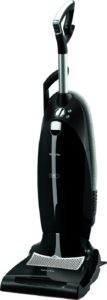
Miele Dynamic U1 Maverick Vacuum: This upright vacuum is a top pick from Good Housekeeping (GH) and Consumer Reports. According to GH, “This…is ideal for pet owners that also suffer from allergies or asthma since its self-sealing bag keeps debris out of the air. It received top-scores in our pet hair pick-up test and basically every other test we put it through.”
- Cost: $599
- Type: Upright
- Use on: Carpet and hardwood floors
- Pros: The flat floor design allows you to easily access hard-to-reach places like underneath furniture, and it has high suction power.
- Cons: Pricey and heavy. This vacuum weighs almost 20 pounds.
2. Best Upright Vacuum
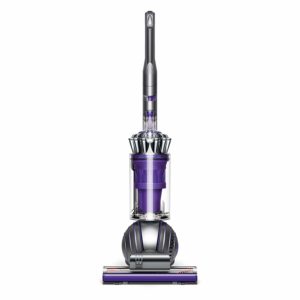
Dyson Ball Animal 2 Upright Vacuum: This cleaner eliminates dog hair on any surface, and the self-adjusting head creates suction whether on the carpet, wood, vinyl, or tile floors. One Amazon reviewer commented, “I used the ‘Tangle-Free Turbine Tool’ to clean the chair the cats sleep on. This chair is always coated in cat hair and was a pain to clean with the DC44. One swipe across with the turbine tool and all the hair was gone!”
- Cost: $399.99
- Type: Upright
- Use on: Any type of flooring
- Pros: Certified asthma and allergy-friendly. The ball head makes maneuverability easy, and the tangle-free turbine tool easily catches dog fur.
- Cons: Not the best fit for a house with stairs. The power cord doesn’t retract and must be wrapped around the cleaner.
Consider this: Dyson created a Groom Tool to supplement its devices and clean your pup. This brush works on medium to long-haired dogs and also removes loose fur.
3. Best Cordless Vacuum

Dyson Cyclone V10 Animal Cordless Stick Vacuum: Another Dyson? Yes, please! This one is light and cord-free. GH said, “Dyson’s super-lightweight (and cordless!) model received perfect scores in our pet hair pick-up tests. Not only was it great at picking up pet hair on floors, [but] it also converts into a hand vac allowing you to easily tackle furniture too.”
- Cost: 429.00
- Type: Stick
- Use on: Any type of flooring
- Pros: Compact, cordless, light, easily cleans under furniture, on stairs, and corners
- Cons: Requires charging
4. Best Robot
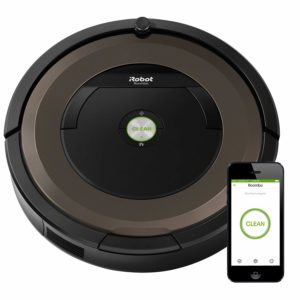
iRobot Roomba 890 Robot Vacuum: Forget the work involved with vacuuming and let this machine get down to business for you. The Roomba has sensors, app control and scheduling, and is compatible with Alexa. One Amazon reviewer commented, “I was both horrified by the amount of dog hair the Roomba was able to find, and also impressed that it found that much dog hair!”
- Cost: $399
- Type: Robotic vacuum, can be controlled and scheduled by its app
- Use on: Any type of flooring. The Roomba’s cleaning head automatically adjusts its height as it switches between hardwood and carpet.
- Pros: Set it and forget it. Roomba says its, “High-Efficiency Filter captures 99% of allergens, pollen, and dust as small as 10 microns.”
- Cons: It can damage electrical cords lying on the floor. The small size requires frequent emptying.
5. Best Handheld

Bissell Pet Hair Eraser Handheld Vacuum: This handheld device scored 4.4 out of 5 stars with more than 7,000 reviews on Amazon. The small cleaner is a great supplement to your upright vacuum. It easily removes fur from furniture, dog beds, and stairs. An Amazon reviewer raved, “[I] researched multiple, reputable consumer reviews for handheld vacs and this little number was consistently in the top running against some high-end competitors… It works great on sucking up dog hair off of furniture and its light weight makes for easy cleaning up for dust boards, walls, crevices, etc. I appreciate the long cord […] as it makes getting around easy.”
- Cost: $34.99
- Type: Handheld
- Use on: Anywhere its cord reaches
- Pros: Inexpensive, two nozzles for different types of cleaning
- Cons: Tethered to the 16-foot cord and its filter must be occasionally replaced
6. Best Vacuum Feature-Set

Bissell Pet Hair Eraser Upright Vacuum with Tangle-Free Brushroll: This cleaner received GH’s seal of approval. They said, “[It] is our go-to because it comes fully stocked with features that’ll suck up every last bit of pet hair. A tangle-free brush roll, a light to find hidden messes, and a detachable canister are all included.”
- Cost: $199.99
- Type: Upright
- Use on: Works on carpets, hard surfaces, and upholstery
- Pros: Swivel steering makes it easy to maneuver, comes with attachments specially tailored for dog hair
- Cons: Some reviewers say this is much better suited for hardwood than carpeted floors. Accessories are not mounted on the vacuum.
Is Your Dog Shedding Like Crazy? This Can Help!
Does your house have stairs? How much carpet? Or maybe you’ve got hardwood floors…pick a vacuum that best fits the amount of fur your pup sheds and your living space. Do you have a better choice? Please share your experience in the comments!
The post 6 Unbeatable Ways To Eliminate Dog Hair From Your Home appeared first on iHeartDogs.com.
via Whisker Therapy
Is Your Dog Suffering From Hot Spots? This Low Cost Amazon Prime Item Works Wonders


You may have noticed your dog scratching and licking at an ugly, red oozing spot on his skin. A hot spot. Hot spots are a type of skin infection caused by bacteria. The spots will be red, moist, and irritated that started with your dog’s picking at it, and made worse by bacteria.
The patch can get bigger in just a few hours and will be very painful for your pet. You’re likely to find them on your dog’s head, neck, hips and limbs. You might notice matted fur or hair loss around the area, along with scabbing and oozing. They’re more common in long-haired dogs in the summer, when the temperature and humidity get higher.
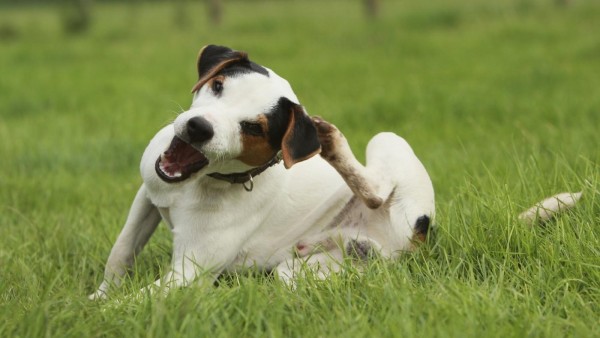
Symptoms of Hot Spots in Dogs
Watch out for these symptoms if you think your dog may be suffering from a hot spot:
– Itchy, painful patch of skin
– Continual chewing or licking at site
– Abnormal aggression (associated with painfulness of site)
– Possible depression (associated with painfulness of site)
– Inflammation, redness, and swelling in a localized patch of skin
– Crusted scabs or oozing sores
– Dry scaly skin
– Hair loss
– Moist, matted fur
– Foul odor from lesion
Causes of Hot Spots in Dogs
The hot spot is initially caused by your dog’s frequent fussing with the spot, perhaps due to one of the following reasons:
– Flea allergies
– Cuts or abrasions
– Ear infection/anal gland infection
– Foreign objects (splinters/thorns)
– Food allergies
– Matted fur Insect bites
– Chewing or licking due to stress or boredom
Bacteria grows with the help of heat and humidity, and gives your dog the inflamed, oozy spot.
Diagnosis of Hot Spots in Dogs
Hot spots are full of bacteria, painful and ugly. Cleaning it at home will help a bit, but proper treatment will require a trip to the vet.
Schedule an appointment as soon as possible (remember, these can get much bigger in just a few hours.) Your vet will conduct a physical exam to find out what caused your dog to start picking at the spot before the infection began. Let your vet know when you noticed symptoms, and anything unusual that might have led to the irritation so the vet can consider possible allergens or stressors.
To air it out and determine severity and size, your vet is likely to shave and clean the area. They may also take bacterial samples for diagnosis.
Treatment of Hot Spots in Dogs
Cleaning
Matted hair around the area will need to be shaved and the area cleaned. Remember, hot spots can cause your dog a lot of pain, and pain-related aggressiveness, so it’s best to allow a professional to do it. They can use a topical antiseptic to clean the spot, such as these popular VetWELL Chlorhexadine wipes on Amazon.
Treating Bacterial Infection
Topical or oral antibiotics will be prescribed to kill the bacteria in the wound, and may need to be taken for several weeks.
Treating Initial Irritation
Your vet will want to treat for whatever caused the initial irritation, be it allergies, fleas, anxiety, etc. They may suggest a change in diet, flea treatment, or exercise and play in the case of anxiety.
Medications for Pain and Inflammation
Antihistamines might be prescribed to reduce itchiness, and NSAIDS to reduce inflammation. Do not give your dog anything not approved by your vet.
Dietary supplements
Essential fatty acids may be suggested for pets prone to skin conditions.
Depending on the severity, your vet may or may not want to see your dog for follow up appointments. Most hot spots clear up pretty quickly. A cone should be used to keep your dog from continuing to lick and chew the spot.
Regular grooming can prevent hot spots, but if your dog doesn’t get groomed regularly, clipping (or shaving, if appropriate for your dog’s coat) can also help prevent matting. Remember to keep your dog on a prescribed flea control program and maintain a stress free home.
You may not notice the spot healing for a week or two, but the medication is doing it’s job and fur should grow back in 3 – 4 weeks. In severe cases, scarring may be possible. Take your pet back to the vet if the hot spots continue.
The post Is Your Dog Suffering From Hot Spots? This Low Cost Amazon Prime Item Works Wonders appeared first on iHeartDogs.com.
via Whisker Therapy
How Dogs' Names Have Changed Through History
In 2019, Britain's most favored names for our four-legged friends are names we'd give to our children, like Charlie, Max, Bella and Luna. But go back hundreds of years and things are radically different. Why call your dog Max when you could go with Magastomo, meaning big mouth?
We explore how names have changed over time and what this says about our relationship with them...
via Whisker Therapy
3 Dangerous Ingredients You're Feeding Your Dog
Are you harming your dog by feeding them the wrong food? We all love our dogs and many consider them our best friends. Many of us even treat them better than our own family members.
There are 3 dangerous ingredients that no dog should ever eat, and if you are giving them to your dog then you might be slowly harming her/him.
Click here to find out these harmful ingredients.
via Whisker Therapy
Does Your Pooch Like To Smooch? The Answer May Surprise You.

How does your pup greet you when you get home after being away? Does your dog give you a kiss? Think about when you’re hanging on the couch. How do you show affection to your pooch? Many people with dogs like to smother them with kisses. But your pup can’t talk. So, does your dog like kisses?
Pucker up!
Kisses are well-accepted displays of affections between humans. So, it makes sense we kiss pups to show them how much we care. But, not every dog loves the sensation. Think about your friends, family, and partners. Everyone has a different love language. The same can be said for canines.
Like humans, some pups are more affectionate than others. Think about your dog’s reaction to your kiss. Does she respond with licks and energetic tail wagging? Or, does your pup stay silent? Some dogs might even find a kiss threatening.
Read body language
It’s simple to tell if your pooch likes this form of affection. Stop reading for a moment and give your pup a kiss. Watch his reaction. If he is alert, tilts his head, licks you in response, or wags his tail, your dog is into it.
Discover Why Baby Talk Is Key to Puppy Love with Your Dog
However, not all dogs feel this way. Are you about to adopt a new pup? Don’t immediately go in for the kiss. This gesture may be foreign and scary to a dog. Get to know each other first so your dog is comfortable. Puppies may not understand kisses at first, but they will learn as they grow.
These are some indicators your dog doesn’t like this attention:
- Growling
- Wiggling away
- Whining
- Hiding
- …and maybe a paw to the face
Why do dogs lick?
Dogs and humans don’t communicate in the same way. Do you lick your friends? For our furry pals, licking is instinctual. This habit begins at birth. Puppies lick their parents to get warmth, learn about their surroundings, and access regurgitated food. This is also how puppies learn what their parents eat.
Many people with dogs experience this behavior from pooch to human, too.
Dana Ebbecke, animal behavior counselor at the ASPCA Adoption Center explained it this way, “The meaning of a dog lick can depend on how the licks are offered to their people…long, slurpy kisses that are accompanied by a soft, wiggly body are usually very affectionate gestures.”
The 10 Most Affectionate Dog Breeds
However, according to Ebbecke, “Sometimes small licks near the mouth are ways for the dogs to get more information into their nose.” This type of licking gives your pup access to smells. Your dog uses the scent to get more information about where you’ve been.
Sometimes, licking is a form of submission to a more dominant dog or a way of figuring out what another dog ate for breakfast.

Are kisses bad?
Short answer: it depends. Where do you kiss your dog? Kisses to the fur and body are safe. But licks to the mouth can have negative consequences. Some will disagree, and that’s okay. But just know that doggy kisses to the mouth come with added risk.
According, Neilanjan Nandi, a professor at the Faculty of Medicine at the University of Drexel, dogs’ bodies have lots of viruses and bacteria that humans can’t fight. This is because dogs are another species, and also because pups lick and eat all sorts of things that are not fit for human consumption, like feces.
8 Potentially Deadly Diseases You Can Get From Your Dog
The nasty bacteria your dog acquires can pass from canine to human. But all is not lost. Leni Kaplan, from the University of Cornell, says that negative consequences for humans are often quite small in healthy people with strong immune systems.
Bottom line: keep kisses away from the mouth to stop the spread of harmful bacteria.
Kiss training
The best way to introduce your pup to kisses is to develop an affectionate relationship from the start. As soon as you get your pup, show them affection. Cuddles and belly scratches are a good place to start. As your dog gets older and builds a rapport with you, they will understand kisses are a good thing.
To train your pup to kiss on command, follow these tips from Wag, “You can hold a treat in your hand and encourage your pooch to lick the hand with the treat. Once they have started doing this, begin using the word ‘kisses’ or a similar word so that they form a link between that word and licking your hand.
Can you feel the love tonight?
There’s no shame in kissing your canine pal. But, be mindful of her body language. It is easy to tell if your pup likes this kind of attention or prefers less physical contact. If you’re looking for another way to show you care, remember that your dog likes staring. Long gazes are hugs without touching. Figure out what your dog likes, and give your pooch love in the way that makes her happiest.
The post Does Your Pooch Like To Smooch? The Answer May Surprise You. appeared first on iHeartDogs.com.
via Whisker Therapy
How To Determine A Dog’s Age
“How old do you think my dog is?”
It’s so natural for guardians to ask this question, but it is equally natural for veterinarians to dread having to answer it. While it is a simple query, it is decidedly complex to offer a reliable response. There are a number of clues that can be used to estimate a dog’s age, but unless the dog is still a puppy, the accuracy of the guess may be anywhere from close to the truth to wildly off.
via Whisker Therapy
Dog Slowing Down? Slower to Rise? Sleeping More? — Try This Time Tested Trick
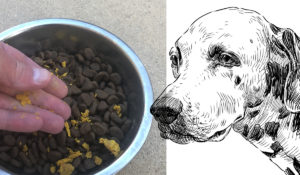
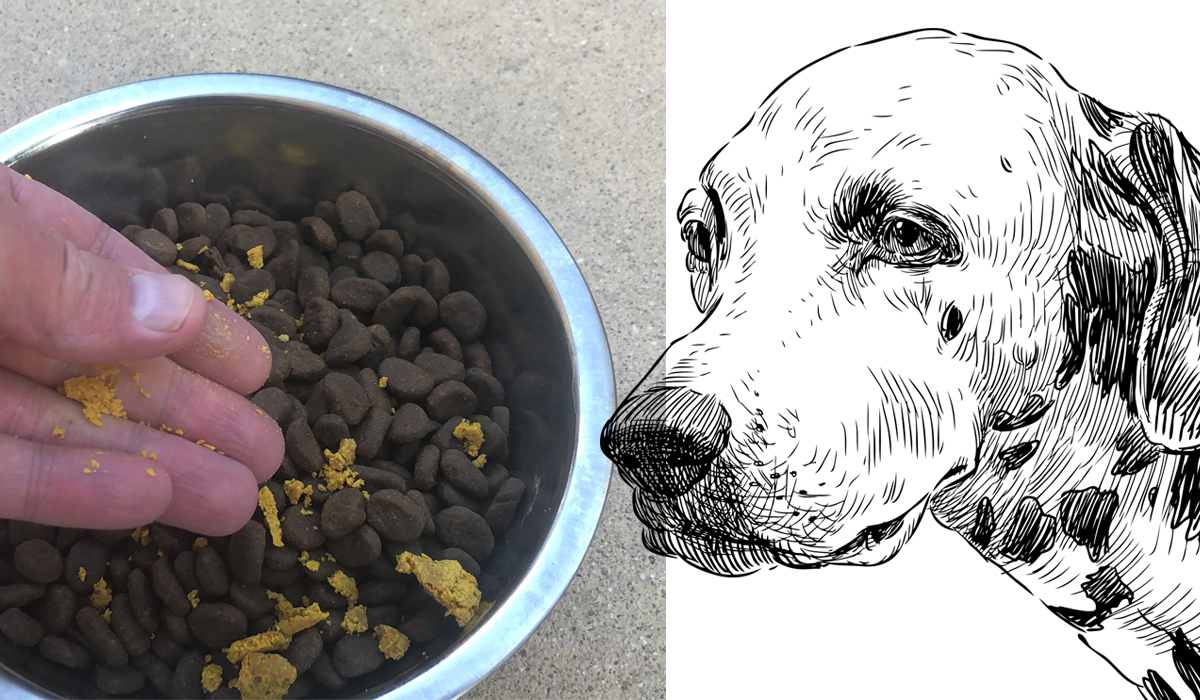
Why Senior Dog Owners Are Obsessed with This Ancient, Golden Spice
Turmeric (or Indian saffron) is the spice that gives curry its yellow color. Veterinary approved supplements for dogs often contain Curcumin – the active ingredient in Turmeric – because it acts as a natural anti-inflammatory and antioxidant.
Researchers and nutritionists are singing its praises as a medicinally effective herb for the mind and body of both people and pets. And while turmeric would likely benefit dogs of any age, its benefits are particularly pronounced for dogs over the age of 7 who have begun experience joint pain and stiffness.
As many senior dog owners know, joint pain and mobility is one of the most common signs of aging. Many owners first notice their dog is slower to get up from sleeping or not greeting them at the door anymore when they come home. Because turmeric and curcumin fights pain and inflammation, it’s is one of the most popular go-to supplements for senior dogs.
How Turmeric / Curcumin Fights Chronic Inflammation & Pain in Older Dogs
Short-term inflammation actually plays a role in keeping the body healthy by fighting off foreign pathogens. Long-term inflammation, on the other hand, is associated with almost every major disease including heart disease, cancer, metabolic syndrome, dementia and various degenerative conditions. One study showed that the power of Curcumin in reducing inflammation may even match that of many anti-inflammatory drugs – without the side effects.
In particular, dogs suffering from joint pain and stiffness may see great benefits from turmeric.
Why It’s Not Recommended to Give Your Dog Turmeric from Your Spice Rack

While some owners simply add ground turmeric from their spice rack to their dog’s dish, there are a few problems with this method.
First, many dogs do not like the taste of turmeric. If you simply sprinkle ground or grated turmeric over your dog’s food, they may turn up their nose and refuse to eat it.
Second, and more importantly, turmeric is poorly absorbed by a dog’s body. Studies have found that two additional nutritional components have been found to greatly aid the absorption: the addition of 1) a healthy fat and 2) black pepper extract.
Because of the need for these 2 additional nutrients, many pet owners turn to a veterinarian formulated supplement that contains turmeric.
The Easiest and Most Cost Effective Way to Add Turmeric to Your Dog’s Diet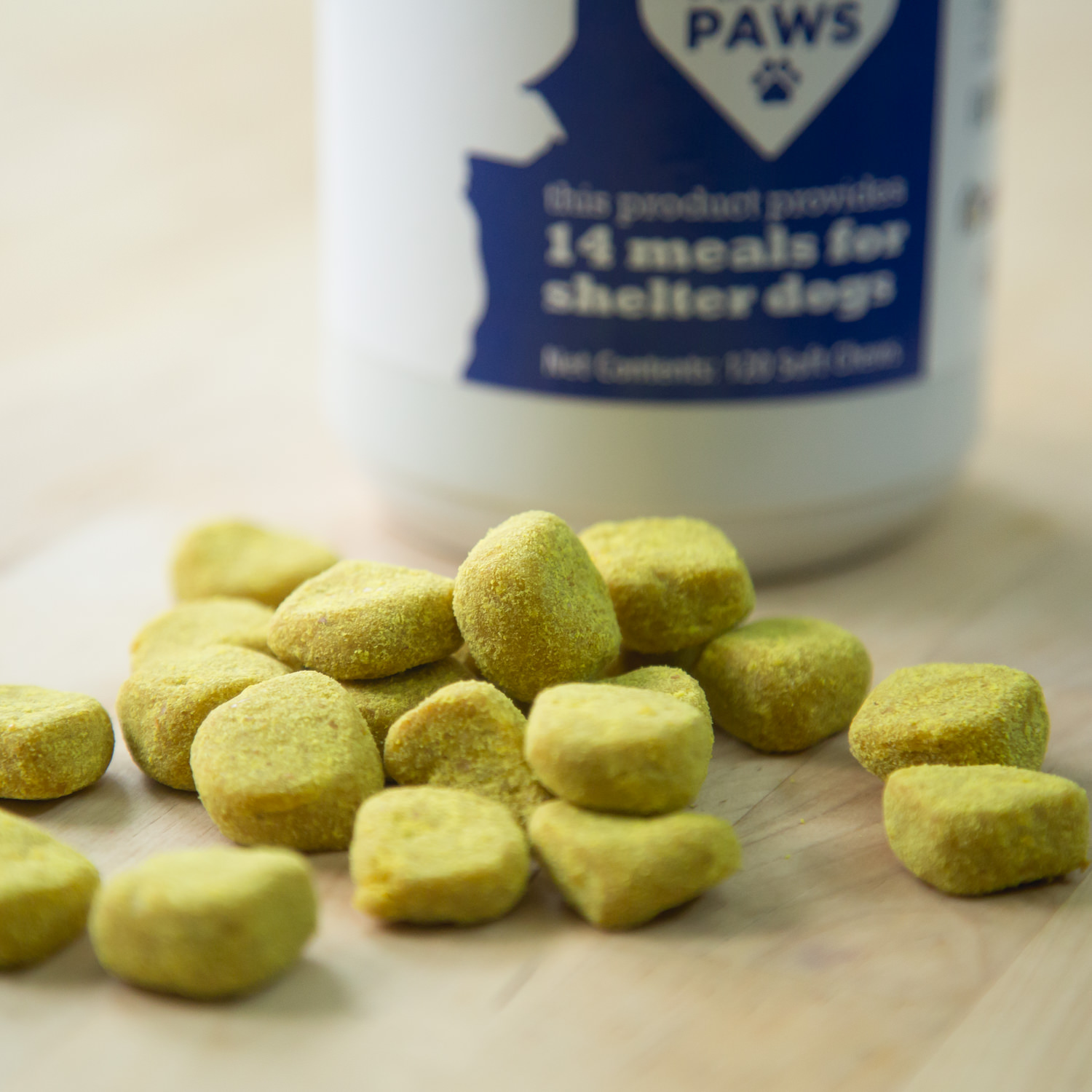
Since nearly all senior dogs are already given a joint care supplement such as glucosamine, for simplicity many owners find a formula that also contains turmeric, a healthy fat, and black pepper extract.
The formula we use and love here at iHeartDogs is the Project Paws™ Brand Advanced Joint Care Supplement with Turmeric. In addition to Turmeric, it contains 7 other active ingredients (such as glucosamine, MSM, and chondroitin) that have been shown to promote healthy joints and mobility. And like any product sold from iHeartDogs.com, each purchase supports animal shelters.
As always, before starting any new medication or supplement you should consult your veterinarian. Turmeric is quite safe in healthy dogs, but may have restrictions for those with certain conditions like kidney stones or diabetes.
These statements have not been evaluated by the Food and Drug Administration. This product is not intended to diagnose, treat, cure, or prevent any disease. The information on this website is not intended to replace a one-on-one relationship with a qualified health care professional.
The post Dog Slowing Down? Slower to Rise? Sleeping More? — Try This Time Tested Trick appeared first on iHeartDogs.com.
via Whisker Therapy
Older Dog Getting Stiff? This Golden Spice Can Get Them Moving Again
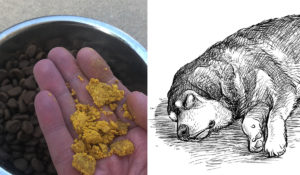
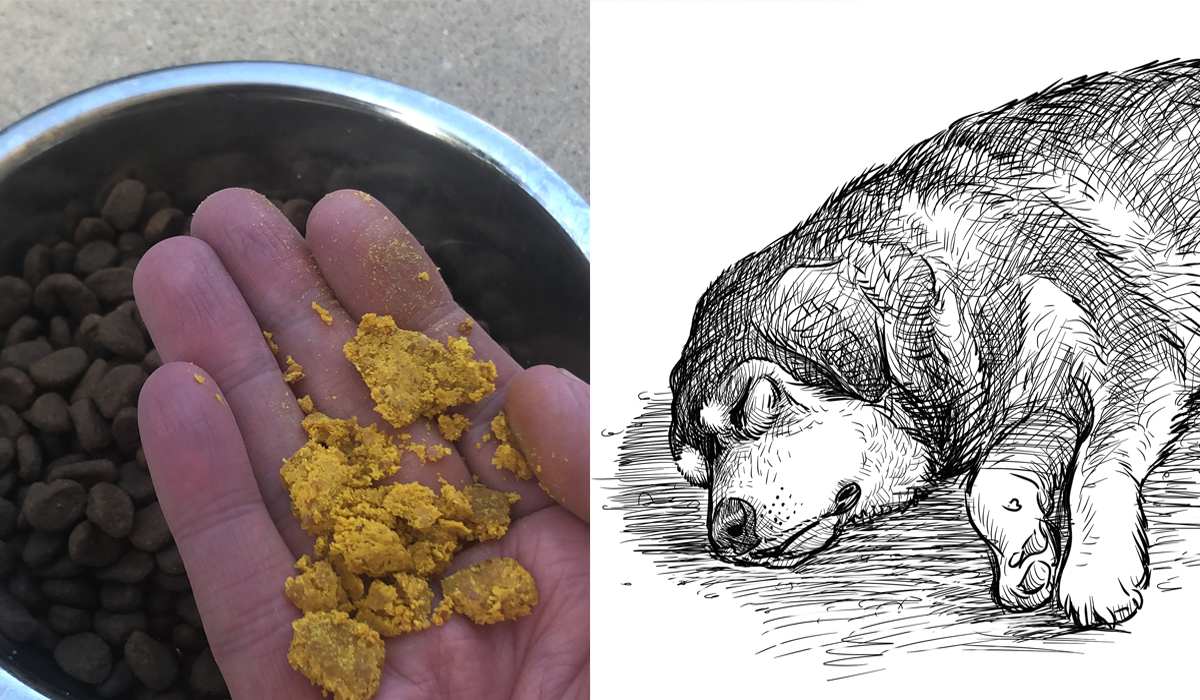
Why Dog Owners Are Obsessed with This Golden Spice
Turmeric (or Indian saffron) is the spice that gives curry its yellow color. Veterinary approved supplements for dogs often contain Curcumin – the active ingredient in Turmeric – because it acts as a natural anti-inflammatory and antioxidant.
Researchers and nutritionists are singing its praises as a medicinally effective herb for the mind and body of both people and pets. And while turmeric would likely benefit dogs of any age, its benefits are particularly pronounced for dogs over the age of 7 who have begun experience joint pain and stiffness.
As many senior dog owners know, joint pain and mobility is one of the most common signs of aging. Many owners first notice their dog is slower to get up from sleeping or not greeting them at the door anymore when they come home. Because turmeric and curcumin fights pain and inflammation, it’s is one of the most popular go-to supplements for senior dogs.
How Turmeric Fights Aging by Reducing Chronic Inflammation & Pain in Dogs
Short-term inflammation actually plays a role in keeping the body healthy by fighting off foreign pathogens. Long-term inflammation, on the other hand, is associated with almost every major disease including heart disease, cancer, metabolic syndrome, dementia and various degenerative conditions. One study showed that the power of Curcumin in reducing inflammation may even match that of many anti-inflammatory drugs – without the side effects.
In particular, dogs suffering from joint pain and stiffness may see great benefits from turmeric.
Why It’s Not Recommended to Give Your Dog Turmeric from Your Spice Rack

While some owners simply add ground turmeric from their spice rack to their dog’s dish, there are a few problems with this method.
First, many dogs do not like the taste of turmeric. If you simply sprinkle ground or grated turmeric over your dog’s food, they may turn up their nose and refuse to eat it.
Second, and more importantly, turmeric is poorly absorbed by a dog’s body. Studies have found that two additional nutritional components have been found to greatly aid the absorption: the addition of 1) a healthy fat and 2) black pepper extract.
Because of the need for these 2 additional nutrients, many pet owners turn to a veterinarian formulated supplement that contains turmeric.
The Easiest and Most Cost Effective Way to Add Turmeric to Your Dog’s Diet
Since nearly all senior dogs are already given a joint care supplement such as glucosamine, for simplicity many owners find a formula that also contains turmeric, a healthy fat, and black pepper extract.
The formula we use and love here at iHeartDogs is the Project Paws™ Brand Advanced Joint Care Supplement with Turmeric. In addition to Turmeric, it contains 7 other active ingredients (such as glucosamine, MSM, and chondroitin) that have been shown to promote healthy joints and mobility. And like any product sold from iHeartDogs.com, each purchase supports animal shelters.
As always, before starting any new medication or supplement you should consult your veterinarian. Turmeric is quite safe in healthy dogs, but may have restrictions for those with certain conditions like kidney stones or diabetes.
These statements have not been evaluated by the Food and Drug Administration. This product is not intended to diagnose, treat, cure, or prevent any disease. The information on this website is not intended to replace a one-on-one relationship with a qualified health care professional.
The post Older Dog Getting Stiff? This Golden Spice Can Get Them Moving Again appeared first on iHeartDogs.com.
via Whisker Therapy
Have an Itchy Dog with Allergies? Here’s Why They Need Krill Oil Daily
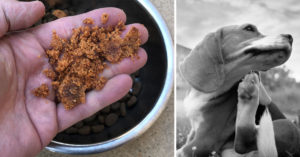
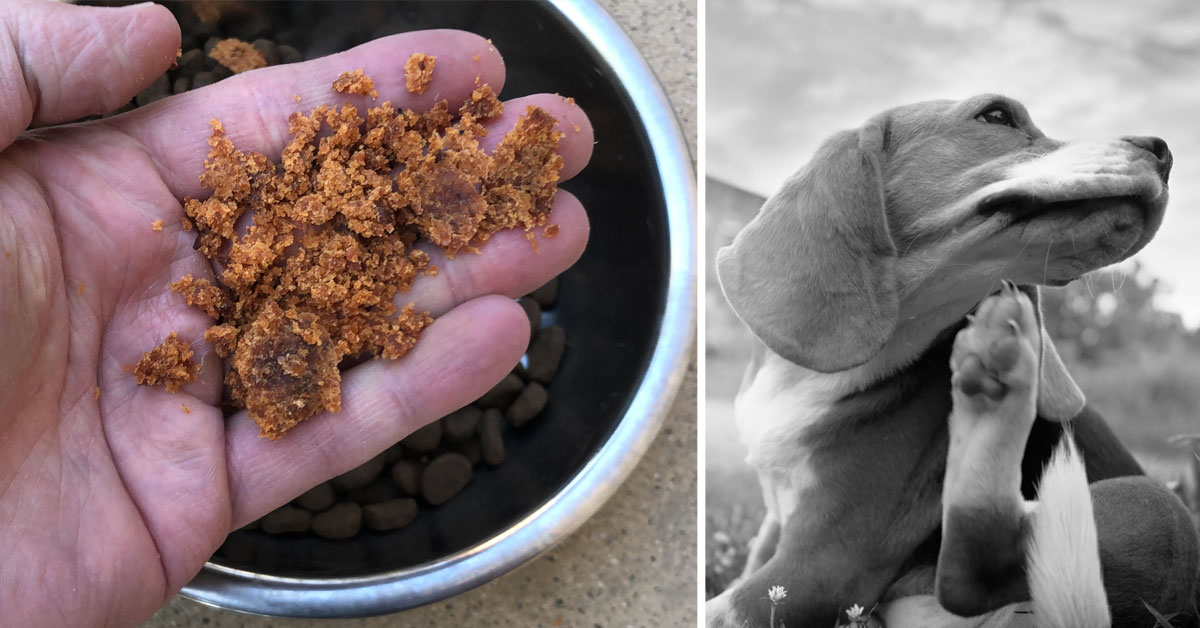
The Reason Dog Owners, Veterinarians, and Scientists Are by The Benefits of These Tiny Red Sea Creatures
Seasonal allergies are the bane of existence for dogs, dog owners, and veterinarians alike.
Especially in the warmer months, many pups suffer immensely from atopic dermatitis, an allergic skin condition that often flares from pollens, molds, or foods in the dog’s environment. If left untreated, it can lead to lesions, hair loss, or bacterial infections.
Studies over the past decade have begun to reveal the importance of Omega-3 Fatty Acids in regulating our immune response to allergies. Sadly, however, most dogs do not receive enough omega-3 in their diet.
Almost All Dogs Do Not Get Enough Omega-3 Fatty Acids in Their Diet – Here’s Why That’s a Serious Problem
Unfortunately, the modern canine diet does not contain an adequate amount of omega-3 fatty acids, which are essential for any mammal to thrive. About 15 years ago, when pet food companies discovered this fact, they began adding in a small amount of fish oil to their formulas. Unfortunately, testing revealed that the omega-3’s found in pet foods are often rancid before they are consumed by the dog, or destroyed in the high-heat processed that kibble undergoes. Even if they did survive, the quantity of omega-3 in dry dog foods are woefully insufficient.
For these reasons, most integrative veterinarians will recommend skipping any food that has fish oil in the formula, and supplementing it instead. (an exception would be for dogs fed a fresh or raw diet, in which the omega-3 oil remain potent)
Dogs missing omega-3 in their diet will often experience hyper-sensitivity to allergens, usually resulting in excessive itching. Omega-3 provides support for a healthy immune system, and can help keep these allergic reactions in check.
Why So Many People Have Switched from Fish Oil to Krill Oil
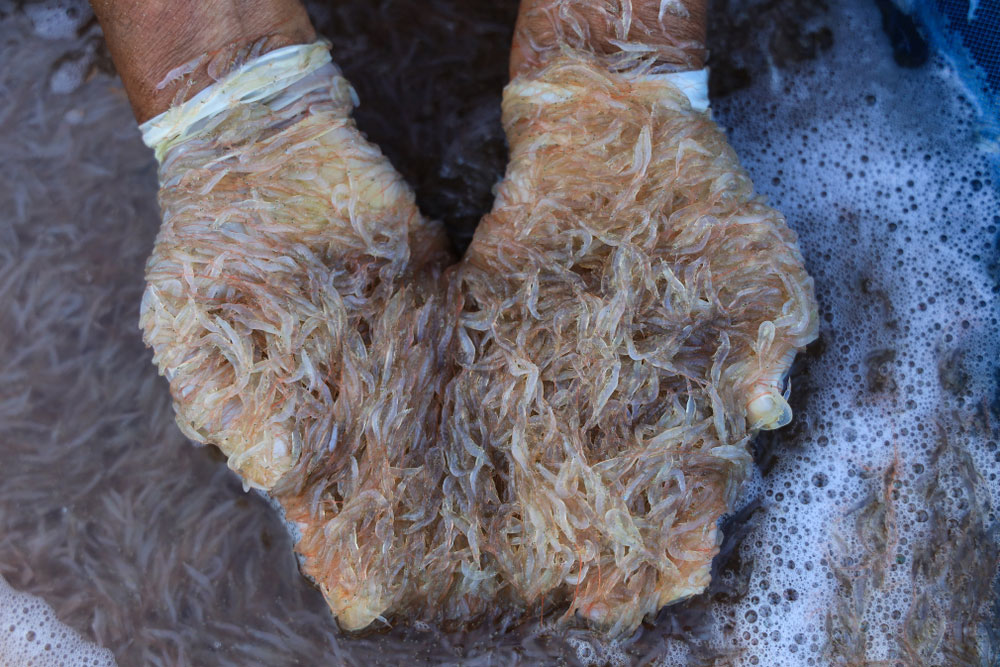
Increasingly, more and more veterinarians are recommending krill oil as the best source of omega-3. Krill oil is a superior source due to 3 reasons:
- It’s up to 3x more bioavailable and absorbable for your dog’s body, due to the phospholipid form of omega-3 found in krill
- Because krill is low on the food chain, its contains absolutely minimal toxins that larger fish often contain
- It’s the most sustainable form of fish oil available
The Krill Oil We Use Ourselves & Recommend
Here at iHeartDogs, our pups love the Project Paws Brand Omega-3 Select krill chews for dogs ($24.99 – 39.99). They’re also available in two sizes: one for small and large dogs.
The company is pretty confident you will see a difference in your dog, because they offer a 90 day satisfaction guarantee, where they will refund you if not satisfied, no matter how much of the bottle you’ve used.
No matter what product you choose, we recommend you do your homework on krill oil supplements for dogs, talk to your veterinarian, and talk to other dog owners. We think you’ll agree once you see the benefits!
These statements have not been evaluated by the Food and Drug Administration. This product is not intended to diagnose, treat, cure, or prevent any disease. The information on this website is not intended to replace a one-on-one relationship with a qualified health care professional.
The post Have an Itchy Dog with Allergies? Here’s Why They Need Krill Oil Daily appeared first on iHeartDogs.com.
via Whisker Therapy







